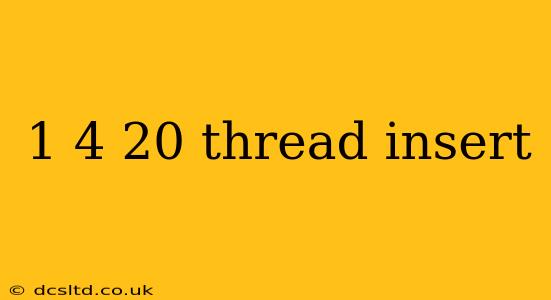Thread inserts, also known as threaded inserts or helicoils, are small, cylindrical components used to reinforce threaded holes and improve their durability. A 1/4"-20 thread insert specifically refers to an insert designed for a 1/4-inch diameter hole with 20 threads per inch. These inserts are invaluable in various applications, preventing stripping and extending the lifespan of parts. This guide will delve into the specifics of 1/4"-20 thread inserts, exploring their types, applications, and installation methods.
What are the Different Types of 1/4"-20 Thread Inserts?
Several types of 1/4"-20 thread inserts exist, each designed for specific applications and material strengths. The most common types include:
-
Helicoils: These are wire-formed inserts that create a stronger, more resilient thread than the original. They're ideal for repairing damaged threads or preventing stripping in softer materials. Their flexibility allows them to conform to the existing hole, making installation relatively straightforward.
-
Keenserts: These inserts are solid, one-piece components that offer excellent strength and durability. They often have a knurled exterior for a secure grip and are installed using a special installation tool. Keenserts are favoured in applications demanding high tensile strength and resistance to vibration.
-
Screw-in Inserts: These inserts are simpler to install, often needing just a screwdriver. They are generally less robust than Helicoils or Keenserts but are suitable for less demanding applications.
-
Ultrasonic Inserts: These are installed using ultrasonic vibration, making them suitable for materials that may be damaged by traditional installation methods. This method offers exceptional precision and reduced risk of material damage during installation.
How are 1/4"-20 Thread Inserts Installed?
The installation process varies depending on the type of insert. Generally, it involves creating a pilot hole of a specific size, then installing the insert using a suitable tool. For Helicoils, a special installation tool is used to coil the wire into the hole. Keenserts typically require a specific installation tool that ensures proper seating and alignment. Screw-in inserts are installed manually, while ultrasonic inserts require specialized equipment.
What are the Applications of 1/4"-20 Thread Inserts?
1/4"-20 thread inserts find widespread use across many industries:
-
Aerospace: Used in aircraft components where strength and reliability are paramount.
-
Automotive: Common in engine parts, chassis components, and other high-stress areas.
-
Manufacturing: Used in machinery, tools, and other equipment to improve durability and prevent thread failure.
-
Electronics: Can be found in enclosures and other components requiring secure threaded connections.
What are the Benefits of Using 1/4"-20 Thread Inserts?
Employing 1/4"-20 thread inserts offers several key advantages:
-
Increased Thread Strength: Significantly enhances the tensile strength of the threaded hole, preventing stripping and breakage.
-
Improved Durability: Extends the lifespan of components, reducing the need for frequent replacements.
-
Repair Capabilities: Allows for the repair of damaged or stripped threads, saving time and resources.
-
Enhanced Vibration Resistance: Provides superior resistance to vibration and fatigue, especially crucial in demanding applications.
What Materials are 1/4"-20 Thread Inserts Made Of?
The materials used for 1/4"-20 thread inserts are typically chosen to match the application and desired performance characteristics. Common materials include:
-
Stainless Steel: Offers excellent corrosion resistance and high strength.
-
Brass: Provides good strength and machinability, often chosen for its ease of installation.
-
Aluminum: Lightweight and corrosion-resistant, suitable for applications where weight is a concern.
How do I Choose the Right 1/4"-20 Thread Insert for My Application?
Selecting the appropriate 1/4"-20 thread insert depends on factors such as:
-
Material of the parent component: The insert material should be compatible with the parent material to ensure a secure bond.
-
Expected load: The insert must be strong enough to withstand the anticipated stress and vibration.
-
Installation method: The chosen method should be compatible with the parent material and the available tools.
-
Environmental conditions: The insert must be resistant to corrosion and other environmental factors.
Choosing the right insert ensures optimal performance and longevity of your threaded components. Consulting with a technical specialist may be helpful for complex applications. Understanding the nuances of 1/4"-20 thread inserts and the options available allows for informed decisions, enhancing both product durability and overall project success.
